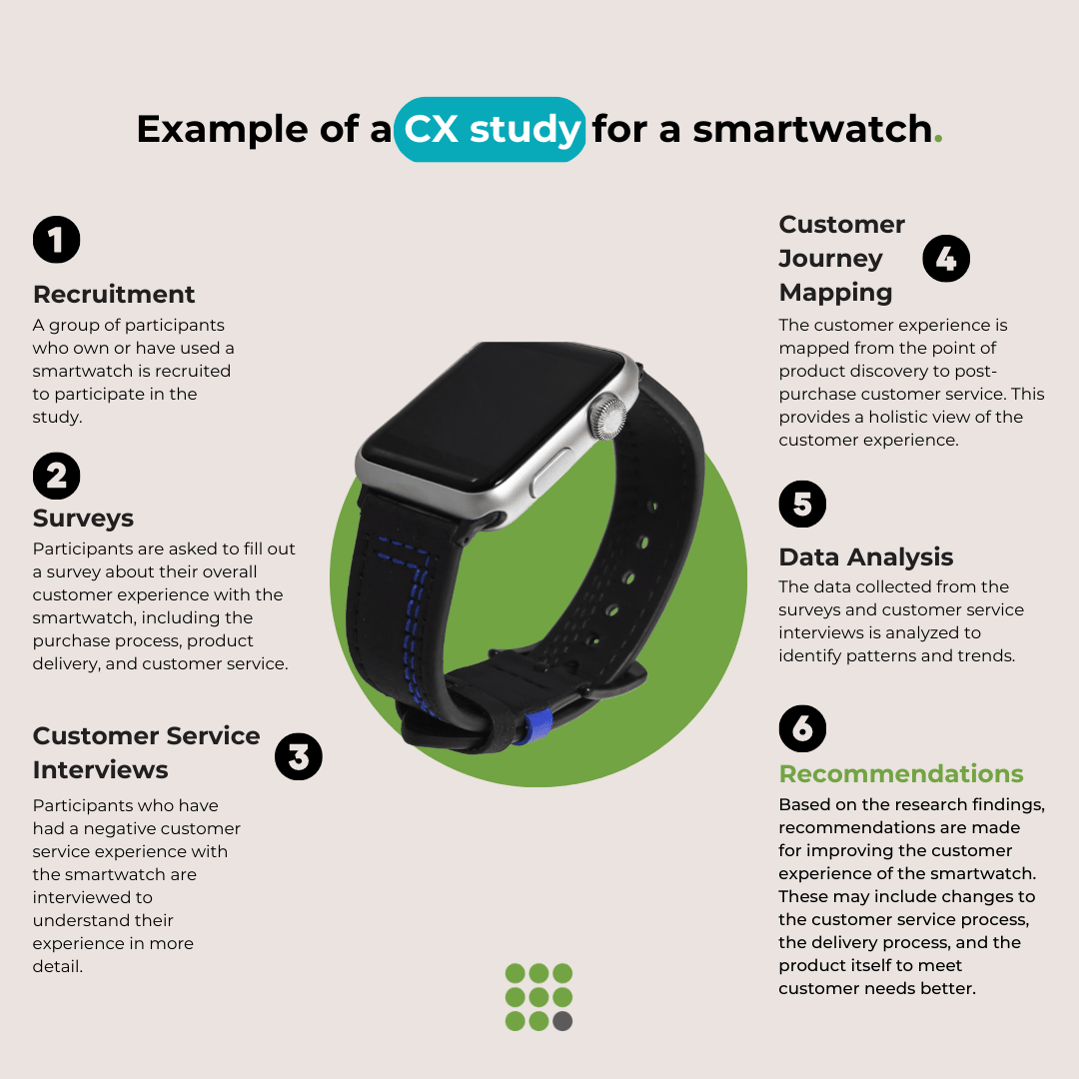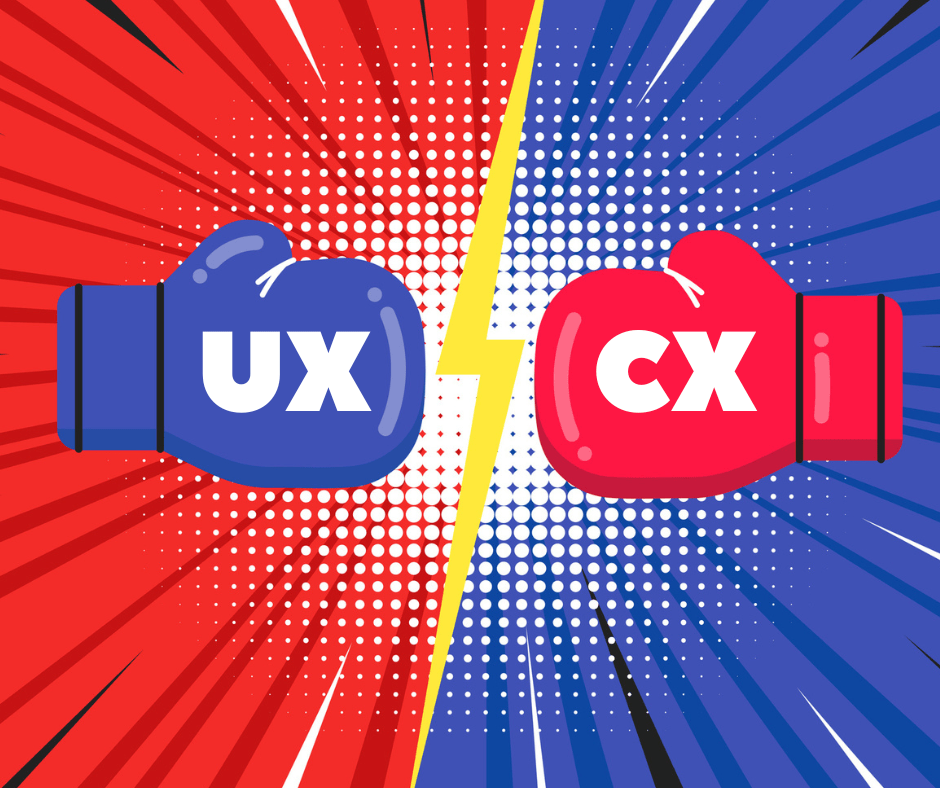UX (User Experience) refers to the overall experience of a person using a product or service, including how easy or enjoyable it is to use and how well it meets their needs. In market research, UX research helps to understand how users interact with and perceive a product and identify improvement areas.
UX market research is also known as:
- User experience research
- User research
- Human-centred design research
- User-centred design research
- Usability research
- User testing
- User insights
- User-centred research
- Human factors research
CX (Customer Experience) refers to a customer’s overall experience with a company, including their interactions with its products, services, and staff. In market research, CX research is conducted to understand the customer’s perspective of the company and identify areas for improvement to enhance the overall customer experience.
CX research is also known as:
- Customer experience research
- Customer satisfaction research
- Customer insights research
- Customer-centric research
- Customer journey research
- Customer feedback research
- Customer engagement research
- Voice of the customer research
- Customer loyalty research
UX research has been used since the 1980s when computers became more widespread in everyday life. At that time, the focus was on improving computer software and hardware’s usability and making it more accessible to users.
CX research has a longer history, as it has been used in the context of customer service and customer relations for many decades. The idea of CX as a key aspect of a company’s brand and marketing strategy became more prominent in the early 2000s as companies began to realise the importance of creating positive and memorable customer experiences.
As technology has continued to advance and customers have become more discerning, UX and CX have become increasingly important in market research. Companies use UX and CX research to gain insights into their customers’ needs, preferences, and behaviours and to create products and services that meet their expectations.
UX and CX are related but distinct concepts in business and market research. UX and CX are both important aspects of business and market research, but they have different goals, focuses, and outcomes. Both are crucial for ensuring customer satisfaction and driving business success.
- Definition: UX refers to the overall experience of a user with a product, including the usability, accessibility, and desirability of the product. CX, on the other hand, refers to the entire customer journey, from initial engagement with a brand to post-purchase customer service.
- Focus: UX research focuses primarily on the design and functionality of the product, while CX research looks at the entire customer experience, including interactions with customer service and the brand.
- Methods: UX research typically involves usability testing, user research, and surveys, while CX research may also involve customer surveys, interviews, and customer journey mapping.
- Goals: The goal of UX research is to improve the design and functionality of the product to create a better user experience, while the purpose of CX research is to improve the overall customer experience and build customer loyalty to the brand.
- Outcome: The outcome of UX research is improved product design and functionality, while the result of CX research is increased customer satisfaction and loyalty.
UX and CX research can be either qualitative or quantitative, depending on the research objectives and the type of data collected.
Quantitative UX and CX research often involve surveys, online polls, and other forms of data collection that generate numerical data, which can analyze and identify patterns and trends.
Qualitative UX and CX research typically involve more in-depth, exploratory methods such as interviews, focus groups, and observation. This type of research is designed to gain a deeper understanding of customers’ thoughts, emotions, and experiences with a product or service.
Brands may conduct UX or CX research to understand their customers better and improve their products or services. Here are some signs that a UX or CX research study may benefit a brand:
- Customer Feedback: If the brand receives a large number of negative comments or complaints from customers about the user experience or customer experience, it may be a sign that a research study is needed.
- Low Customer Satisfaction: If the brand’s customer satisfaction scores are low, it may indicate that there is room for improvement in the customer experience.
- High Customer Churn: If the brand has a high customer churn rate, or if customers are not returning to use their products or services, it may be a sign of a problem with the customer experience.
- Competitor Advantage: If competitors offer better user or customer experiences, research can help the brand understand how it can improve to remain competitive.
- Product Development: If the brand is developing a new product or service, UX or CX research can provide valuable insights into the needs and preferences of the target customer.
Consider the tables below for a smartwatch to show further the differences and parallels in UX and CX market research.


Examples of UX Research Questions
While there are some similarities in how UX and CX market research is conducted, the questions are often very different.
UX questions help to identify areas for improvement in the product and provide valuable insights into the user experience. The answers to these questions can inform design and development decisions to create a better user experience and improve customer satisfaction.
Here are some examples of research questions that might be asked in a UX market research study:
- How easy or difficult is it for users to navigate the interface of the product?
- How intuitive is the product design and layout?
- How well do the features of the product meet the needs of users?
- Are any areas of the product that could be clearer or easier to use?
- How efficient and effective is the product in performing its intended tasks?
- How satisfied are users with the overall user experience of the product?
- What are the users’ expectations of the product, and how well does the product meet those expectations?
- Are there any frustrations or pain points with the product that users would like to see improved?
- Are there any unmet needs or desires for new features users would like to see added to the product?
- How does the product compare to similar products in terms of user experience?
Examples of CX Research Questions
Conversely, CX research questions help to identify areas for improvement in the customer experience and provide valuable insights into customer needs and preferences. The answers to these questions can inform customer-focused initiatives and drive business success.
Here are some examples of research questions that might be asked in a CX market research study:
- How easily can customers find information about the product and make a purchase?
- How satisfied are customers with the purchase process, including delivery and payment options?
- How well does the company handle customer service inquiries and issues?
- How satisfied are customers with the post-purchase customer service experience?
- How well does the company meet customer expectations for product quality and performance?
- How do customers perceive the brand, and how does this affect their loyalty to the brand?
- What factors influence customer satisfaction with the product and overall customer experience?
- How does the customer experience with the product compare to similar products in the market?
- How well does the company understand and address the needs and preferences of its customers?
- How well does the company handle customer feedback and incorporate it into product development and customer service initiatives?
While UX and CX have different business area focuses, several research methodologies are complementary. By incorporating these complementary areas into UX and CX research, companies can gain a more comprehensive understanding of their customers and users and make informed decisions about product design and customer experience.
These include:
- Brand Research: Brand research focuses on the reputation and perception of a brand, which can impact the overall customer experience.
- Customer Segmentation: Customer segmentation helps to identify different customer groups and understand their needs, preferences, and behaviours, which can inform UX and CX research.
- Voice of the Customer (VOC): Voice of the customer research involves collecting customer feedback and opinions about products, services, and the overall customer experience, which can inform UX and CX research.
- User Persona Development: User persona development involves creating detailed profiles of typical users, which can help to inform UX design and CX strategies.
- Surveys: Surveys can be used to gather data and feedback from customers and users, which can inform UX and CX research.
- Behavioral Analysis: Behavioral analysis involves observing and analyzing user behaviours, which can inform UX design and CX strategies.
- Customer Journey Mapping: Customer journey mapping involves mapping out the different stages of the customer journey and understanding customer needs, preferences, and behaviours at each stage, which can inform UX and CX research.
Why should brands monitor UX and CX collectively?
UX and CX are important to monitor because they play a crucial role in determining the success and competitiveness of a company in today’s market.
Monitoring UX and CX provides several benefits, including:
Customer Satisfaction: Monitoring UX and CX helps companies understand customer needs, preferences, and satisfaction and improve the customer experience to increase customer satisfaction.
Improved User Experience: Monitoring UX helps companies understand user behaviours and preferences and make improvements to the design and functionality of their products to enhance the user experience.
Increased Loyalty and Retention: A positive customer experience leads to increased customer loyalty and retention, which is essential for long-term business success.
Better Business Decisions: Monitoring UX and CX provides valuable insights into customer and user behaviours and attitudes, which can inform better business decisions.
Competitive Advantage: Brands that prioritise UX and CX can differentiate themselves from their competitors and gain a competitive advantage in their market.
Increased Revenue: Companies that invest in UX and CX can increase customer satisfaction and loyalty, leading to increased revenue.
The frequency of UX and CX research can vary depending on several factors, such as the size and complexity of the product or service, the target audience, the research goals, and the research budget available.
For UX research, it is common to conduct user testing and research at crucial stages of the product development cycle, such as during prototyping, before launching a new product or feature, or when making major updates to an existing product. The frequency of UX research can range from one-off studies to ongoing research and testing.
For CX research, companies may conduct studies regularly, such as annually or bi-annually, to track customer satisfaction and feedback over time. This type of research can also be undertaken after key customer interactions, such as after a purchase or customer service interaction, to gather real-time feedback.
In general, it is recommended that companies continuously monitor and gather data on both UX and CX to make informed decisions and improve their products and services over time.
If you would like to improve your user or customer experience, Kadence International would love to assist. Simply, get in touch or submit a research brief.


